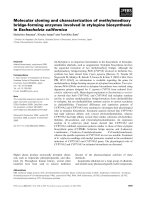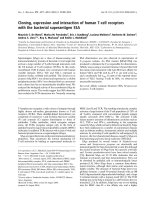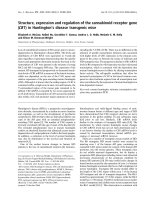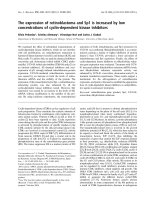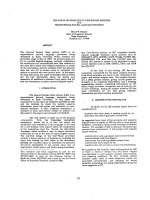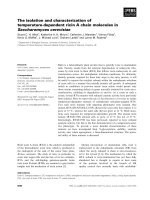báo cáo khoa học: "The expression and role of protein kinase C (PKC) epsilon in clear cell renal cell carcinoma" ppt
Bạn đang xem bản rút gọn của tài liệu. Xem và tải ngay bản đầy đủ của tài liệu tại đây (1.08 MB, 9 trang )
RESEARC H Open Access
The expression and role of protein kinase C (PKC)
epsilon in clear cell renal cell carcinoma
Bin Huang
1†
, Kaiyuan Cao
2†
, Xiubo Li
3
, Shengjie Guo
4
, Xiaopeng Mao
1
, Zhu Wang
2
, Jintao Zhuang
1
,
Jincheng Pan
1
, Chengqiang Mo
1
, Junxing Chen
1*
and Shaopeng Qiu
1*
Abstract
Protein kinase C epsilon (PKCε), an oncogene overexpressed in several human cancers, is involved in cell
proliferation, migration, invasion, and survival. However, its roles in clear cell renal cell carcinoma (RCC) are unclear.
This study aimed to investigate the functions of PKCε in RCC, especially in clear cell RCC, to determine the
possibility of using it as a therapeutic target. By immunohistochemistry, we found that the expression of PKCε was
up-regulated in RCCs and was associated with tumor Fuhrman grade and T stage in clear cell RCCs. Clone
formation, wound healing, and Borden assays showed that down-regulating PKCε by RNA interference resulted in
inhibition of the growth, migration, and invasion of clear cell RCC cell line 769P and, more importantly, sensitized
cells to chemotherapeutic drugs as indicated by enhanced activity of caspase-3 in PKCε siRNA-transfected cells.
These results indicate that the over expression of PKCε is associated with an aggressive phenotype of clear cell RCC
and may be a potential therapeutic target for this disease.
Keywords: Protein kinase C epsilon, Renal cell carcinoma, Clear cell
Background
Renal cell carcinoma (RCC) accounts for approximately
3% of all malignant tumors in adults, which afflicts
about 58, 240 people and causes nearly 13, 040 deaths
each year in USA [1]. RCCs are classified into five major
subtypes: clear cell (the most important type, accounts
for 82%), papillary, chromophobe, collecting duct, and
unclassified RCC [2]. Operation is the first treatment
choice for RCC; however, some patients already have
metastasis at the time of diagnosis and are resistant to
conventional chemotherapy, radiotherapy, and immu-
notherapy [3]. Thus, a more effective anti-tumor therapy
is urgently needed.
Protein kinase C ( PKC), a family of phospholipid-
dependent serine/threonine kinases, plays an important
role in intracellular signaling in cancer [4-8]. To date, at
least 11 PKC family members have been identified. PKC
isoenzymes can be categorized in to three groups by
their structural and biochemical properties: the
conventional or classical ones (a, bI, bII, and g)require
Ca
2+
and diacylglycerol (DAG) for their activation; the
novel ones (δ, ε, h ,andθ)aredependentonDAGbut
not Ca
2+
; the atypical ones (ζ and l/ι) are independent
of both Ca
2+
and DAG [4-6]. Among them, PKCε is the
only isoenzyme that has been considered as an onco-
gene which regulates cancer cell proliferation, migration,
invasion, chemo-resistance, and differentiation via the
cell signaling network by interacting with three major
factors RhoA/C, Stat3, and Akt [9-13]. PKCε is overex-
pressed in many types of cancer, including bla dder can-
cer [14], prostate cancer [15], breast cancer [16], head
and neck squamous cell carcinoma [17], and lung cancer
[18] as well as RCC cell lines [19,20]. The overexpres-
sion and functions of PKCε imply its potential as a ther-
apeutic target of cancer.
In this study, we detected the expression of PKCε in
128 human primary RCC tissues and 15 normal tissues
and found that PKCε expression was up-regulated in
the se tumors and correlated with tumor grade. Further-
more, PKCε regulated cell proliferation, colony forma-
tion, invasion, migration, and chemo-resistance of clear
cell RCC cells. Those results suggest that PKCε is
* Correspondence: ;
† Contributed equally
1
Department of Urology, the First Affiliated Hospital, Sun Yat-Sen Universi ty,
Guangzhou (510080), China
Full list of author information is available at the end of the article
Huang et al. Journal of Experimental & Clinical Cancer Research 2011, 30:88
/>© 2011 Huan g et al; licensee BioMed Central Ltd. This is an Open Access a rticle distributed under the terms of the Creative Commons
Attribution License (http://c reativecommons.org/licenses/by/2.0), which permits unrestricted use, distribution, and reproduction in
any medium, provided the original work is properly cited.
crucial for survival of clear cell RCC cells and may serve
as a therapeutic target of RCC.
Methods
Samples
We collected 128 specimens of resected RCC and 15
specimens of pericancerous normal renal tissues from
the First Affiliated Hospital of the Sun Yat-sen Univer-
sity (Guangzhou, China). All RCC patients were treated
by radical nephrectomy or partial resection. Of the 1 28
RCC samples, 10 were papillary RCC, 10 were chromo-
phobe RCC, and 108 were clear cell RCC according to
the 2002 AJCC/UICC classification. The clear cell RCC
samples were from 69 male patients and 39 female
patients at a median age of 56.5 years (range, 30 to 81
years). Tumors were staged according to the 2002 TNM
staging system [21] and graded according to the Fuhr-
man four-grade system [22]. Informed consent was
obtained from all patients to allow the use of samples
and clinical data for investigation. This study was
approved by the Ethics Council of the Sun Yat-sen Uni-
versity for Approval of Research Involving Human
Subjects.
Cell culture
Five human RCC cell lines 769P, 786-O, OS-RC-2,
SN12C, and SKRC39 were used in this research. Clear
cell RCC cell lines 769P and 786-O were purchased
from the American Type Culture Collection (Rockville,
MD); RCC cell lines OS-RC-2, SN12C, and SKRC39
wereakindgiftfromDr.ZhuoweiLiu(Departmentof
Urology, Sun Yat-sen University Cancer Center). 769P,
786-O, OS-RC-2, and SKRC39 cells were cultured in
RPMI-1640 (Gibco, C arlsbad, California); SN12C cells
were maintained in Dulbeccos’s modified Eagle’smed-
ium (DMEM, Gibco) containing 10% fetal calf serum
(FCS, Gibco, Carlsbad, California), 1% (v/v) penicillin,
and 100 μg/ml streptomycin at 37°C in a 5% CO
2
atmosphere.
Immunohistochemistry and scoring for PKCε expression
All 5-μm thick paraffin sections of tissue samples were
deparaffinized with xylene and rehydrated through
graded alcohol washes, followed by antigen retrieval by
heating sections in sodium citrate buffer (10 mM, pH
6.0) for 30 min. Endogenous peroxidase activity was
blocked with 30 min incubation in methanol containing
0.03% H
2
O
2
. The slides were then incubated in PBS (pH
7.4) containing normal goat serum (dilution 1:10) and
subsequently incubated with monoclonal mouse IgG1
anti-PKCε antibody (610085; BD Biosciences, BD, Frank-
lin Lakes, NJ USA) with 1:200 dilution at 4°C overnight.
Following this step, slides were treated with biotin-
labeled anti-IgG and incubated with avidin-biotin
peroxidase complex. Reaction products were visualized
by diaminobenzidine (DAB) staining and Meyer’shema-
toxylin counterstaining. Negative controls were prepared
by replacing the primary antibody with mouse IgG1
(I1904-79G, Stratech Scientific Ltd, UK). Phosphate-buf-
fered saline instead of primary antibody was used for
blank controls.
Three independent pathologists blinded to clinical
data scored PKCε immunohistochemical staining of all
sections according to staining intensity and the percen-
tage of positive tumor cells as follows [23,24]: no stain-
ing scored 0; faint or moderate staining in ≤ 25% of
tumor cells scored 1; moderate or strong staining in
25% to 50% of tumor cells scored 2; strong staining in
≥50% of tumor cells scored 3. For each section, 10 ran-
domly selected areas were observed under high magni-
fication and 100 tumor cells in each area were counted
to calculate the proportion of positive cells. Overex-
pression of PKCε wa s defined as staining i ndex ≥2.
Immunohistochemical reactions for all samples were
repeated at least three times and typical results were
illustrated.
Western blot analysis for PKCε expression
The expression of PKCε in 769P, 786-O, OS-RC-2,
SN12C, and SKRC39 cells was detected by Western blot
as described previously [25]. Briefly, total proteins were
extracted from RCC cell lines and denatured in sodium
dodecyl sulfate (SDS) sample buffer, then equally loaded
onto 10% polyacrylamide gel. After electrophoresis, the
proteins were transferred to a polyvinylidene difluoride
memb rane. Blot s were incubated with the indicated pri-
mary antibodies overnight at 4°C and detected with
horseradish peroxidase-conjugated secondary antibody.
The monoclonal anti-PKCε antibody was used at the
dilution of 1:3, 000, whereas anti-GAPDH (sc-137179;
Santa Cruz Biotechnology, Santa Cruz, CA, USA) was
used at the dilution of 1:2, 000.
Immunocytochemistry for PKCε expression and location
769P cells were washed with 1× PBS and fixed in 4%
paraformaldehyde for 10 min at room temperature,
blocked in 0.1% PBS-Tween solution containing 5%
donkey serum (v/v) at room temperature for 1 h, and
incubated overnight with anti-PKCε antibody (1:300) in
blocking solution. Then cells were washed three times
for 10 min with 0.1% PBS-Tween and incubated for 1 h
with secondary antibody in blocking solution.
DyLight488-conjugated AffiniPure donkey anti-mouse
IgG (H + L) was used at the dilution of 1:500
(715485151, Jackson ImmunoResearch Europe, Newmar-
ket, Suffolk, UK). After incubation, cells were washed
three times with 0.1% PBS-Tween, counterstained with
Hoechst 33342, and mounted for confocal microscopy.
Huang et al. Journal of Experimental & Clinical Cancer Research 2011, 30:88
/>Page 2 of 9
The expression and location of PKCε in cells were
observed under a fluorescent microscope.
RNA interference (RNAi) to knockdown PKCε in 769P cells
As described in literature [26-28], 769P cells were trans-
fected with small interfering RNA (siRNA) against PKCε
(sc-36251) and negative control siRNA (sc-37007) by
Lipofectamine 2000 transfection reagent and Opti-
MEMTM (Invitrogen, Carlsbad, CA, USA) according to
the manufacturer’s protocol. All siRNAs were obtai ned
from Santa Cruz Biotechnology. Briefly, 1 × 10
5
769P
cells were plated in each well of 6-well plates and cul-
tured to reach a 90% confluence. Cells were then trans -
fected with siRNA by using the transfection reagent in
serum-free medium. Total cellular proteins were isolated
at 48 h after transfection. PKCε expression was moni-
tored by reverse transcription-polymerase chain reaction
(RT-PCR) and Western blot using the anti-PKCε anti-
body mentioned above.
Reverse transcription-polymerase chain reaction
Total RNA was isolated from 769P cells transfected with
PKCε siRNA or control siRNA, or from untransfected
cells using TRIzol Reagent (Invitrogen) as per the manu-
facturer’s protocol, and subjected to reverse transcrip-
tion using reverse transcriptase Premix Ex Taq (Takara,
Otsu, Japan). The sequences of PKCε primers used for
PCR were as follows: forward, 5’-ATGGTAGTGTT-
CAATGGCCTTCT-3’ ; reverse, 5’ -TCAGGGCAT-
CAGGTCTTCAC-3’ . The sequences of internal control
glyceraldehyde-3-phosphate dehydrog enase (GAPDH)
were as follows: forward, 5’ -ATGTCGTGGAGTCTA
CTGGC-3’; reverse, 5’-TGACCTTGCCCACAGCCTTG-
3’ .PKCε was amplified by 30 cycles of denaturation at
95°C for 1 min, annealing at 60°C for 30 s, extensi on at
72°C for 2 min, and final extension at 72°C for 8 min.
The products were resolved on a 1% agarose gel con-
taining ethidium bromide for electropheresis.
Colony formation assay
Cell proliferation was assessed by colony formation
assay. PKCε siRNA-transfected, control siRNA-trans-
fected, and untransfected 769P cells were seeded in a
6-well plate (1 × 10
3
cells/well ), and cultured in com-
plete medium for 1 week. Cell colonies were then visua-
lized by 0.25% crystal violet. After washing out the dye,
colonies containing > 50 cells were counted. The colony
formation efficiency (CFE) was the ratio of the colony
number to the planted cell number.
Wound-healing assay
Cell migration was evaluated by a scratched wound-
healing assay on plastic plate wells. In brief, 769P cells
were seeded in a 6-well plate (5 × 10
5
cells/well) and
grew to confluence. The monolayer culture was
scratched with a sterile micropipette tip to create a
denuded zone (gap) of constant width and the cell deb-
ris with PBS was removed. The initial gap length and
the residual gap length at 6, 12, or 24 h after wounding
were observed under an inverted microscope (ZEISS
AXIO OBSERVER Z1) and photographed. The wound
area was measured by the program Image J http://rsb.
info.nih.gov/ij/. The percentage of wound closure was
estimated by 1 - (wound area at Tt/wound area at T0) ×
100%, where Tt is the time after wounding and T0 is
the time immediately after wounding.
Invasion assay
Cell invasion was assessed using the CHEMICON cell
invasion assay kit (Millipore, Billerica, MA, USA)
according to the manufacturer ’ s instructions. In brief,
300 μl of warm serum-free medium was added into the
interior of each insert (8 μm pore size) to rehydrate the
extracellular matrix (ECM) layer for 2 h at room tem-
perature, then it was replaced with 300 μl of prepared
serum-free suspension of untransfected 769P cells, or
cells transfected with PKCε siRNA or control siRNA (5
×10
5
cells/ml); 500 μl of medium containing 1 0% fetal
bovine serum was added to the lower chamber of the
insert. Cells were incubated at 37°C in a 5% CO
2
atmo-
sphere for 24 h. After then, non-invading cells in the
interior of the inserts were gently removed with a cot-
ton-tipped swab; invasive cells on the lower surface of
the inserts were stained with the staining solution for 20
min and counted under a microscope. All experiments
were performed in triplicate.
Drug sensitivity assay
At 48 h after siRNA transfection, transfected and
untransfected cells were seeded into a 96-well plate at a
density of 5 × 10
3
cell s/well. After 24 h, cells were trea-
ted with various doses of sunitinib or 5-fluorouracil
(Sigma, St Louis, MO, USA) for additional 48 h. Cell
viability was measured by the MTT assay following the
manufacturer’s instructions. All experiments were per-
formed in triplicate.
Caspase-3 activity assay
The activity of caspase-3 was determined using the cas-
pase-3 activity kit (Beyotime, Haimen, China), b ased on
the ability of caspase-3 to change acetyl-Asp-Glu-Val-
Asp p-nitroanilide (Ac-DEVD-pNA) into a yellow for-
mazan product p-nitroaniline (pNA) [29,30]. According
to the manufacturer’s protocol, cell lysates of transfected
and untransfected 769P cells after drug treatment as
described above were centrifuged at 12, 000 × g for 15
min at 4°C, and protein concentrations were determined
by Bradford protein assay. Cellular extracts (30 μg) were
Huang et al. Journal of Experimental & Clinical Cancer Research 2011, 30:88
/>Page 3 of 9
incubated in a 96-well microtitre plate with 10 μlAc-
DEVD-pNA (2 mM) for 6 h a t 37°C. Then caspase-3
activity was quantifie d in the samples with a microplate
spectrophotometer (NanoDrop 2000c, Thermo Fisher
Scientific Inc., USA) by the absorbance at a wavelength
of 405 nm. All experiments were performed in triplicate.
Statistical analysis
Statistical analysis was performed using the SPSS
13.0 software. The relationship between PKCε
expression and the clinicopathologic features of RCC
was assessed by the Fischer’ s exact test. Continuous
data are expressed as mean ± standard deviation.
Statistical significance was analyzed by one-way
analysis of variance (ANOVA) followed by Bonferro-
ni’ s post-hoc test, with values of P <0.05considered
statistically significant.
Results
PKCε expression in renal tissues
The expression of PKCε protein in 15 specimens of nor-
mal renal tissues and 128 specimens of RCC was
detected by immunohistochemistry with an anti-PKCε
monoclonal an tibody. PKCε expression was weak in
normal renal tissues, but strong in both cytoplasm and
nuclei of RCC cells (Figure 1). The level of PKCε over-
exp ression was significantly higher in RCC tha n in nor-
mal tissues (63.3% vs. 26.7%, P = 0.006). When stratified
Figure 1 Immunohistochemical staining of PKCε in tissue specimens. PKCε is overexpressed in both cytoplasm and nuclei of clear cell renal
cell carcinoma (RCC) cells (A). Primary antibody isotype control (B) and normal renal cells (C) show no or minimal staining. The original
magnification was ×200 for left panels and ×400 for right panels.
Huang et al. Journal of Experimental & Clinical Cancer Research 2011, 30:88
/>Page 4 of 9
by pathologic type, no significant difference was
observed among clear cell, papillary, and chromophobe
RCCs (62.0% vs. 60.0% and 80.0%, P = 0.517). PKCε
overexpression showed no relationship with the sex and
age of p atients with clear cell RCC (both P > 0.05), but
was related with higher T stage (P < 0.05) and higher
Fuhrman grade (P < 0.01) (Table 1).
PKCε expression in renal cell cancer cell lines
We detected the expression of PKCε in five RCC cell
lines using Western blot. PKCε was expressed in all five
RCC cell lines at various levels, with the maximum level
in clear cell RCC cell line 769P (Figure 2A). Immunocy-
tochemical staining showed that PKCε was mainly
expressed in both cytoplasm and nuclei, sometimes on
the membrane, of 769P cells (Figure 2B).
Effects of PKCε on proliferation, migration, and invasion
of 769P cells
To examine the functions of PKCε, we knocked down
PKCε by transf ecting PKCε siRNA into 769P cells. The
mRNA and protein expression of PKCε was signifi-
cantly weaker in PKCε siRNA-transfected cells than in
control siRNA-transfected cells and untransfected cells
(Figure 3A and 3B). The colony formation assay
revealed that cell colony formation efficiency were
lower in PKCε siRNA -transfected cells than in control
siRNA-transfected and untransfected cells [(29.6 ±
1.4)% vs. (60.9 ± 1.5)% a nd (50.9 ± 1.1)%, P < 0.05],
suggesting that PKCε maybeimportantforthegrowth
and survival of RCC cells.
The wound-healing assay also demonstrated signifi-
cant cell migration inhibition in PKCε siRNA-trans-
fected cells compared with control siRNA-transfected
and untransfected cells a t 24 h after wounding [wound
closure ratio: (42.6 ± 5 .3)% vs. (77.1 ± 4.1)% and (87.2
±5.5)%,P < 0.05] (Figure 3C). The CHEMICON cell
invasion assay demonstrated that the number of invad-
ing cells was significantly decreased in PKCε siRNA
group compared with control siRNA and blank control
groups (120.9 ± 8.1 vs. 279.0 ± 8.3 and 308.5 ± 8.8, P
< 0.01) (Figure 3D). Our data implied that PKCε
knockdown also inhibited cell migration and invasion
in vitro.
Knockdown of PKCε sensitizes 769P cells to
chemotherapy in vitro
As PKCε is involved in drug resistance in some types of
cancer and adjuvant chemotherapy is commonly used to
treat RCC, we tested whether PKCε is also involved in
drug response of RCC cell lines. Both siRNA-transfected
and untransfected 769P cells were treated with either
sunitinib or 5-fluorouracil. The survival rates of 769P
cells after treatment with Sunitinib and 5-fluorouracil
were significantly lower in PKCε siRNA group than in
control siRNA and blank control groups (all P <0.01)
(Figure 4).
Caspase-3 is the final executor of apoptotic DNA
damage, and its activity is a characteristic of apoptosis
[10]. We next examined cell apoptosis after siRNA
transfection and treatme nt with cytotoxic drug sunitinib
or 5-fluorouracil. At 48 h, the caspase-3 activity was sig-
nificantly higher in PKCε siRNA-transfected cells, ei ther
with or without drug treatment, than in untransfected
cells (P < 0.01) (Figure 5A), and was significant ly higher
in the cells underwent both siRNA transfectio n and
Table 1 PKCε overexpression in human clear cell renal
cell carcinoma tissues
Group Cases PKCε overexpression P value
(-) (+)
Sex
Men 69 24 45 0.365
Women 39 17 22
Age
≤ 55 years 43 16 27 0.599
>55 years 65 21 44
T stage
T
1/
T
2
89 38 51 0.028
T
3
/T
4
19 3 16
Fuhrman grade
G
1
/G
2
86 39 47 0.002
G
3
/G
4
22 2 20
PKCε, protein kinase C epsilon.
Figure 2 Expression of PKCε in renal cell carcinoma (RCC) cell
lines. A. Western blot shows that PKCε is expressed in all five RCC
cell lines, with the highest level in 769P cells. GAPDH is the loading
control. B. Immunocytochemical staining with PKCε antibody shows
that PKCε is mainly expressed in cytoplasm and nuclei of 769P cells
(original magnification×200). Green fluorescence indicates PKCε-
positive cells, whereas blue fluorescence indicates the nuclei of the
cells. The first panel is a merge image of the latter two.
Huang et al. Journal of Experimental & Clinical Cancer Research 2011, 30:88
/>Page 5 of 9
Figure 3 Effects of PKCε knockdown on migration, and invasion of 769P cells. 769P cells were transfected with PKCε small interfering RNA
(siRNA) or control siRNA; untransfected cells were used as blank control. GAPDH was used as internal control. Both reverse transcription-
polymerase chain reaction (A) and Western blot (B) show that PKCε expression is inhibited after PKCε RNAi. C. The wound-healing assay shows a
significant decrease in the wound healing rate of 769P cells after PKCε siRNA transfection (*, P < 0.05). D. Invasion assay shows a significant
decrease in invaded 769P cells after PKCε siRNA transfection (**, P < 0.01).
Huang et al. Journal of Experimental & Clinical Cancer Research 2011, 30:88
/>Page 6 of 9
drug treatment than in those underwent only drug treat-
ment (P < 0.05) (Figure 5B), s uggesting that PKCε may
contribute to the resistance of clear cell RCC cells to
cytotoxic drugs.
Discussion
Increasing evidences indicate that PKCε is overexpressed
in various tumor tissues and functions as a transforming
oncogene [14-20]. To explore the oncogenic potential of
PKCε, Mischak et al. [31] overexpressed PKCε in NIH
3T3 fibroblasts and observed accelerated growth of cells
with PKCε overexpression. In addition, tumors were
developed in all mice injected with PKCε-overexpressing
NIH 3T3 cells . In the same year, Cacace et al. [32] con-
firmed the oncogenic role of PKCε in fibroblasts. Simi-
larly, Perletti et al. [33] found that PKCε overexpression
in colonic epithelial cells led to a metastatic phenotype,
including morphological changes, increased anchorage-
independent growth and tumorigenesis in a xenograft
model. We also found that PKCε was overexpressed in
RCC tissues as compared with that in normal renal tis-
sues and that PKCε was closely related to higher grades
of clear cell RCC. PKCε was also expressed in all five
human RCC cell lines used in our study.
PKCε has been shown to regulate many cellular pro-
cesses, including cell proliferation, migration, invasion,
chemo-resistance, apoptosis, and differentiation [9-12].
Multiple mechanisms are involved in PKCε-regulated
tumorigenesis. For example, PKCε promotes cell prolif-
eration and survival by regulating the R as signaling
pathway, which is a well characterized signaling pathway
in cancer biology [10,34]. PKCε expression is related to
the activation of c yclin D1 promoter, a downstream
effects of Ras signaling, and to enhanced cell growth
[9-11]. In addition, PKCε plays a role in anti-apoptotic
signaling pathways through interacting with caspases
and Bcl-2 family members [35,36], and exerts its
pro-survival effects by activating Akt/PKB [27,37]. These
mechanisms may explain the inhibited growth of RCC
cells by PKCε knockdown in our study.
Like in other cancer type s, relapse a nd metastasis are
the main causes of failure of surgical operation in
Figure 4 Knockdown of PKCε sensitizes 769P cells to Sunitinib
(A) and 5-fluorouracil (B). 769P cells were transfected with PKCε
siRNA or control siRNA; untransfected cells were used as blank
control. At 72 h after siRNA transfection, cells were treated with
sunitinib (0.2, 1, and 5 μM) or 5-fluorouracil (1.25, 2.5, and 5 μg/ml)
for another 48 h. MTT assay shows increased sensitivity of cells to
sunitinib and 5-fluorouracil after siRNA transfection (**, P < 0.01).
Figure 5 Changes of caspase-3 activity in 769P cells after PKCε
downregulated and cytotoxic drug treatment. 769P cells were
transfected with PKCε siRNA; untransfected cells were used as blank
control. At 72 h after siRNA transfection, cells were treated with
indicated doses of sunitinib or 5-fluorouracil. Panel A shows that the
caspase-3 activity was significantly higher in PKCε siRNA-transfected
cells, either with or without drug treatment, than in untransfected
cells (P < 0.01) and was higher in the cells underwent both siRNA
transfection and drug treatment than in those underwent only
siRNA transfection (P < 0.05). Panel B shows that the caspase-3
activity was significantly higher in the cells underwent both siRNA
transfection and drug treatment than in those underwent only drug
treatment (P < 0.05).
Huang et al. Journal of Experimental & Clinical Cancer Research 2011, 30:88
/>Page 7 of 9
treating clear cell RCC. Patients with RCC response to
postoperative adjuvant chemotherapy at various levels
and usually cannot achieve expected outcomes [3]. The
phenotype of tumor metastasis presents with promo-
tion of cell proliferation, escape from apoptosis, and
dysregulation of c ellular adhesion and migration. The
invasion of tumor cells to surrounding tissues and
spreading to distal sites rely on cell migration ability.
Cell migration, a complex event, depends on the coor-
dinated remodeling of the actin cytoskeleton, regulated
assembly, and turnover of focal adhesion [11]. Interest-
ingly, PKCε contains an actin-binding domain [12] and
promotes F-actin assembly in a cell-free system, indi-
cating that PKCε modulates cell migration via actin
polymers. In addition, PKCε has been observed to
translocate to the cell membrane d uring the formation
of focal adhesions [38] and to reverse the effect of
non-signaling b1-integrin molecules in inhibiting cell
spreading [39]. PKCε-driven cell migration was shown
to be mediated, at least in part, by activating down-
stream small Rho GTPases, especially RhoA and/or
RhoC [17]. We found that silencing PKCε by RNAi
decreased migration and invasion of clear cell RCC
cells in vitro,suggestingthatPKCε maybeoneofthe
potential treatment targets for this disease. Addition-
ally, PKCε is also cleaved by caspases in response to
several apoptotic stimuli including chemotherapeutic
agents. PKCε is a substrate for caspase-3 as evidenced
by caspase-3-caused PKCε cleavage and the inhibition
of PKCε cleavage by a cell permeable inhibitor of cas-
pase-3 [40]. PKCε has been shown to regulate apopto-
sis mediated by either DNA damage or receptor [10].
PKCε up-regulation was associated with chemoresis-
tance of non-small cell lung cancer (NSCLC) cell lines,
whereas chemosensitivity was proved in P KCε-knock-
down SCLC cells [41]. In addition, PKCε was reported
to mediate with induction of the drug-resistance gene
P-glycoprotein in LNCaP cells [42]. In our study, PKCε
knockdown enhanced the activity of pro-apoptotic
gene caspase-3 and sensitized 769P cells to chemother-
apy, indicating the association between PKCε and che-
mosensitivity of RCC.
Conclusions
Our results confirm the role of PKCε as an oncogene in
RCC, especially in the subtype of clear cell, suggesting
that PKCε might be a potential treatment target for this
disease, which warrants verification in further studies.
Acknowledgements
This work was supported by grants from the National Natural Science
Foundation of China (No. 30872584, 81071760, 30772503); Guangdong
Natural Science Foundation (No. 8251008901000018); Sun Yat-sen Innovative
Talents Cultivation Program for Excellent Tutors (No. 80000-3126205); and
Science and Technology Planning Project of Guangdong Province, China
(No. 2011B050400021, 2008B080701021).
Author details
1
Department of Urology, the First Affiliated Hospital, Sun Yat-Sen Universi ty,
Guangzhou (510080), China.
2
Research Center for Clinical Laboratory
Standard, Zhongshan Medical School, Sun Yat-sen University, Guangzhou
(510080), China.
3
Pulmonary disease institute, Guangzhou Chest Hospital
Pulmonary Disease Institute, Guangzhou (510095), China.
4
Department of
Urology, Sun Yat-Sen University Cancer Center, Guangzhou (510060), China.
Authors’ contributions
JTZ, JCP and CQM evaluated the immunostainings. BH have made
substantial contributions to acquisition of data. XBL, SJG and ZW performed
the statistical analysis. BH, JXC and SPQ participated in the design of the
study. BH and KYC drafted the manuscript. XPM and SPQ revised the
manuscript. All authors read and approved the final manuscript.
Competing interests
The authors declare that they have no competing interests.
Received: 16 August 2011 Accepted: 28 September 2011
Published: 28 September 2011
References
1. Jemal A, Siegel R, Xu J, Ward E: Cancer statistics, 2010. CA Cancer J Clin
2010, 60:277-300.
2. Klatte T, Pantuck AJ, Kleid MD, Belldegrun AS: Understanding the natural
biology of kidney cancer: implications for targeted cancer therapy. Rev
Urol 2007, 9:47-56.
3. Finley DS, Pantuck AJ, Belldegrun AS: Tumor biology and prognostic
factors in renal cell carcinoma. Oncologist 2011, 16:4-13.
4. Jaken S: Protein kinase C isozymes and substrates. Curr Opin Cell Biol
8(1996):168-173.
5. Newton AC: Regulation of the ABC kinases by phosphorylation: protein
kinase C as a paradigm. Biochem J 2003, 370:361-371.
6. Parker PJ, Parkinson SJ: AGC protein kinase phosphorylation and protein
kinase C. Biochem Soc Trans 2001, 29:860-863.
7. Griner EM, Kazanietz MG: Protein kinase C and other diacylglycerol
effectors in cancer. Nat Rev Cancer 2007, 7:281-294.
8. Gutcher I, Webb PR, Anderson NG: The isoform-specific regulation of
apoptosis by protein kinase C. Cell Mol Life Sci 2003, 60:1061-1070.
9. Gorin MA, Pan Q: Protein kinase Cε: an oncogene and emerging tumor
biomarker. Mol Cancer 2009, 8:9.
10. Basu A, Sivaprasad U: Protein kinase Cε makes the life and death
decision. Cell Signal 2007, 19:1633-1642.
11. Akita Y: Protein kinase Cepsilon: multiple roles in the function of and
signaling mediated by, the cytoskeleton. FEBS J 2008, 275:3995-4004.
12. Akita Y: Protein kinase Cε (PKCε): its unique structure and function. J
Biochem 2002, 132:847-852.
13. Totoń E, Ignatowicz E, Skrzeczkowska K, Rybczyńska M: Protein kinase Cε as
a cancer marker and target for anticancer therapy. Pharmacol Rep 2011,
63:19-29.
14.
Varga A, Czifra G, Tallai B, Németh T, Kovács I, Kovács L, Bíró T: Tumor
grade-dependent alterations in the protein kinase C isoform pattern in
urinary bladder carcinomas. Eur Urol 2004, 46:462-465.
15. Wu D, Foreman TL, Gregory CW, McJilton MA, Wescott GG, Ford OH,
Alvey RF, Mohler JL, Terrian DM: Protein kinase cepsilon has the potential
to advance the recurrence of human prostate cancer. Cancer Res 2002,
62:2423-2429.
16. Pan Q, Bao LW, Kleer CG, Sabel MS, Griffith KA, Teknos TN, Merajver SD:
Protein kinase C epsilon is a predictive biomarker of aggressive breast
cancer and a validated target for RNA interference anticancer therapy.
Cancer Res 2005, 65:8366-8371.
17. Pan Q, Bao LW, Teknos TN, Merajver SD: Targeted disruption of protein
kinase C epsilon reduces cell invasion and motility through inactivation
of RhoA and RhoC GTPases in head and neck squamous cell carcinoma.
Cancer Res 2006, 66:9379-9384.
18. Bae KM, Wang H, Jiang G, Chen MG, Lu L, Xiao L: Protein kinase C
epsilon is overexpressed in primary human non-small cell lung cancers
and functionally required for proliferation of non-small cell lung
Huang et al. Journal of Experimental & Clinical Cancer Research 2011, 30:88
/>Page 8 of 9
cancer cells in a p21/Cip1 -dependent manner. Cancer Res 2007,
67:6053-6063.
19. Brenner W, Benzing F, Gudejko-Thiel J, Fischer R, Färber G, Hengstler JG,
Seliger B, Thüroff JW: Regulation of beta1 integrin expression by
PKCepsilon in renal cancer cells. Int J Oncol 2004, 25:1157-1163.
20. Engers R, Mrzyk S, Springer E, Fabbro D, Weissgerber G, Gernharz CD,
Gabbert HE: Protein kinase C in human renal cell carcinomas: role in
invasion and differential isoenzyme expression. Br J Cancer 2000,
82:1063-1069.
21. Green FL, Page DL, Fleming ID, et al: AJCC Cancer Staging Manual.
Springer: New York;, 6 2002.
22. Fuhrman SA, Lasky LC, Limas C: Prognostic significance of morphologic
parameters in renal cell carcinoma. Am J Surg Pathol 1982, 6:655-663.
23. Yamada S, Yanamoto S, Kawasaki G, Rokutanda S, Yonezawa H, Kawakita A,
Nemoto TK: Overexpression of CRKII increases migration and invasive
potential in oral squamous cell carcinoma. Cancer Letters 2011, 303:84-91.
24. Fu L, Qin YR, Xie D, Chow HY, Ngai SM, Kwong DL, Li Y, Guan XY:
Identification of alpha-actinin 4 and 67 kDa laminin receptor as stage-
specific markers in esophageal cancer via proteomic approaches. Cancer
2007, 110:2672-2681.
25. Guo S, Mao X, Chen J, Huang B, Jin C, Xu Z, Qiu S: Overexpression of Pim-
1 in bladder cancer. J Exp Clin Cancer Res 2010, 29:161.
26. Pedram A, Razandi M, Wallace DC, Levin ER: Functional estrogen receptors
in the mitochondria of breast cancer cells. Mol Biol Cell 2006, 17:2125-37.
27. Lu D, Huang J, Basu A: Protein kinase C epsilon activates protein kinase
B/Akt via DNA-PK to protect against tumor necrosis factor-alpha-
induced cell death. J Biol Chem 2006, 281:22799-22807.
28. Hu B, Shen B, Su Y, Geard CR, Balajee AS: Protein kinase C ε is involved in
ionizing radiation induced bystander response in human cells. Int J
Biochem Cell Biol 2009, 41:2413-2421.
29. Wei X, Juan ZX, Min FX, Nan C, Hua ZX, Qing FZ, Zheng L: Recombinant
immunotoxin anti-c-Met/PE38KDEL inhibits proliferation and promotes
apoptosis of gastric cancer cells. J Exp Clin Cancer Res 2011, 30:67.
30. Zhao CQ, Liu Da, Li Hai, Jiang LS, Dai LY: Interleukin-1b enhances the
effect of serum deprivation on rat annular cell apoptosis. Apoptosis 2007,
12:2155-2161.
31. Mischak H, Goodnight JA, Kolch W, Martiny-Baron G, Schaechtle C,
Kazanietz MG, Blumberg PM, Pierce JH, Mushinski JF: Overexpression of
protein kinase C-delta and -epsilon in NIH 3T3 cells induces opposite
effects on growth, morphology, anchorage dependence, and
tumorigenicity. J Biol Chem 1993, 268:6090-6096.
32. Cacace AM, Guadagno SN, Krauss RS, Fabbro D, Weinstein IB: The epsilon
isoform of protein kinase C is an oncogene when overexpressed in rat
fibroblasts. Oncogene 1993, 8:2095-2104.
33. Perletti GP, Folini M, Lin HC, Mischak H, Piccinini F, Tashjian AH Jr:
Overexpression of protein kinase C epsilon is oncogenic in rat colonic
epithelial cells. Oncogene 1996, 12:847-854.
34. Hamilton M, Liao J, Cathcart MK, Wolfman A: Constitutive association of c-
N-Ras with c-Raf-1 and protein kinase Cε in latent signaling modules. J
Biol Chem 2001, 276:29079-29090.
35. Sivaprasad U, Shankar E, Basu A: Protein kinase C-epsilon protects MCF-7
cells from TNF-mediated cell death by inhibiting Bax translocation. Cell
Death Differ 2007, 14:851-860.
36. McJilton MA, Van Sikes C, Wescott GG: Protein kinase Cepsilon interacts
with Bax and promotes survival of human prostate cancer cells.
Oncogene 2003, 22:7958-7968.
37. Wu D, Thakore CU, Wescott GG, McCubrey JA, Terrian DM: Integrin
signaling links protein kinase Cepsilon to the protein kinase B/Akt
survival pathway in recurrent prostate cancer cells. Oncogene 2004,
23:8659-8672.
38. Hernandez RM, Wescott GG, Mayhew MW, McJilton MA, Terrian DM:
Biochemical and morphogenic effects of the interaction between
protein kinase C-epsilon and actin in vitro and in cultured NIH3T3 cells.
J Cell Biochem 2001, 83:532-546.
39. Berrier AL, Mastrangelo AM, Downward J, Ginsberg M, LaFlamme SE:
Activated R-ras. Rac1, PI 3-kinase and PKCepsilon can each restore cell
spreading inhibited by isolated integrin beta1 cytoplasmic domains. J
Cell Biol 2000, 151:1549-1560.
40. Hoppe J, Hoppe V, Schafer R: Selective degradation of the PKC-epsilon
isoform during cell death in AKR-2B fibroblasts. Exp Cell Res 2001,
266:64-73.
41. Mayne GC, Murray AW: Evidence that protein kinase Cepsilon mediates
phorbol ester inhibition of calphostin C- and tumor necrosis factor-
alpha-induced apoptosis in U937 histiocytic lymphoma cells. J Biol Chem
1998, 273:24115-24121.
42. Flescher E, Rotem R: Protein kinase C epsilon mediates the induction of
P-glycoprotein in LNCaP prostate carcinoma cells. Cell Signal 2002,
14:37-43.
doi:10.1186/1756-9966-30-88
Cite this article as: Huang et al.: The expression and role of protein
kinase C (PKC) epsilon in clear cell renal cell carcinoma. Journal of
Experimental & Clinical Cancer Research 2011 30:88.
Submit your next manuscript to BioMed Central
and take full advantage of:
• Convenient online submission
• Thorough peer review
• No space constraints or color figure charges
• Immediate publication on acceptance
• Inclusion in PubMed, CAS, Scopus and Google Scholar
• Research which is freely available for redistribution
Submit your manuscript at
www.biomedcentral.com/submit
Huang et al. Journal of Experimental & Clinical Cancer Research 2011, 30:88
/>Page 9 of 9



